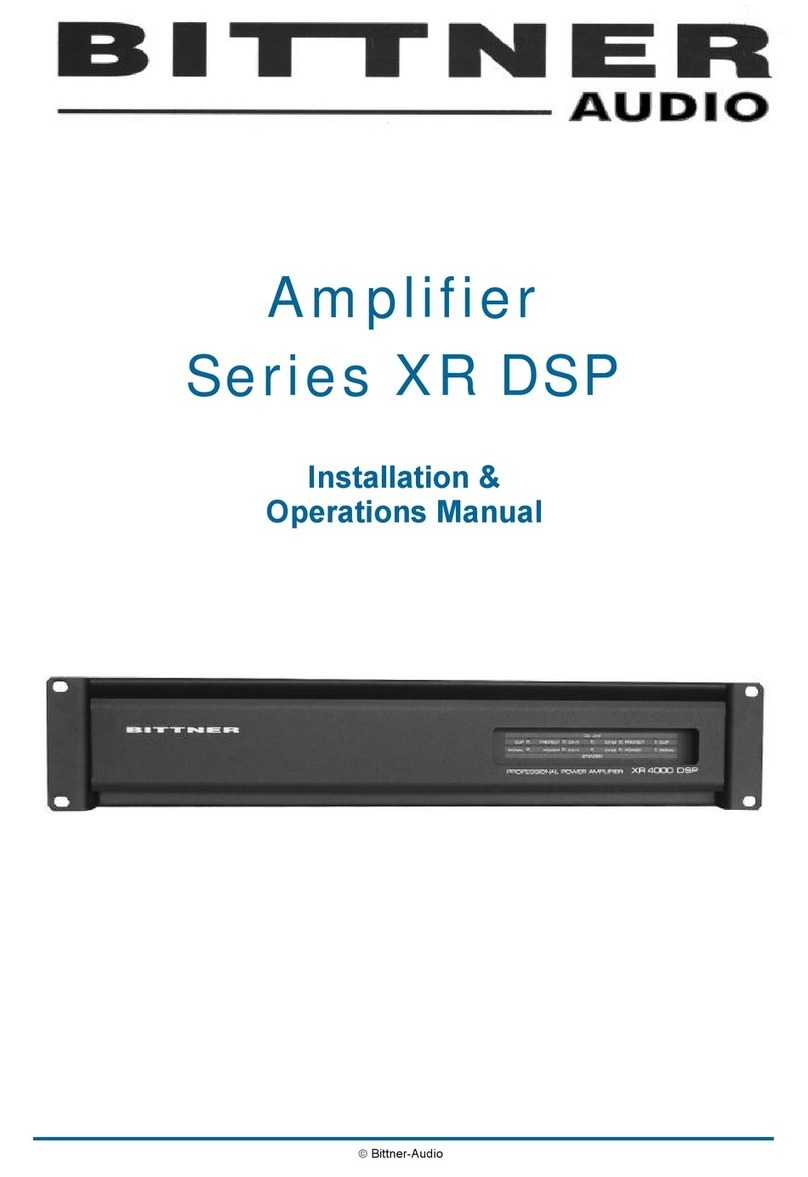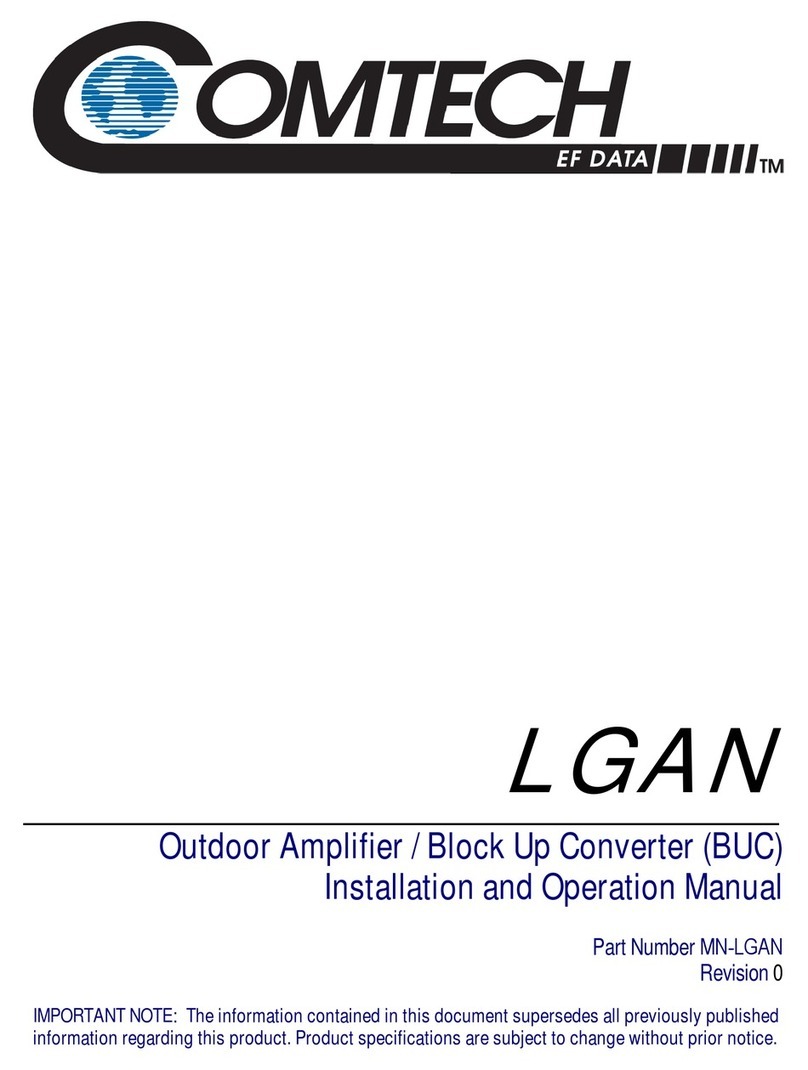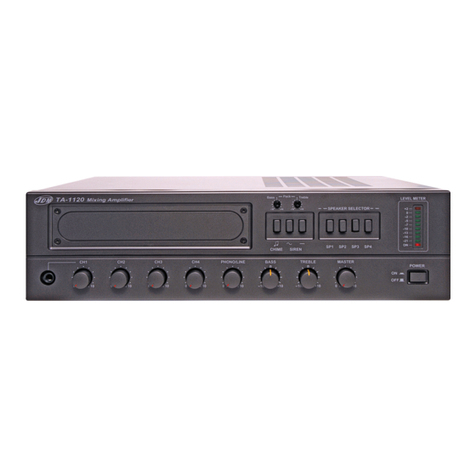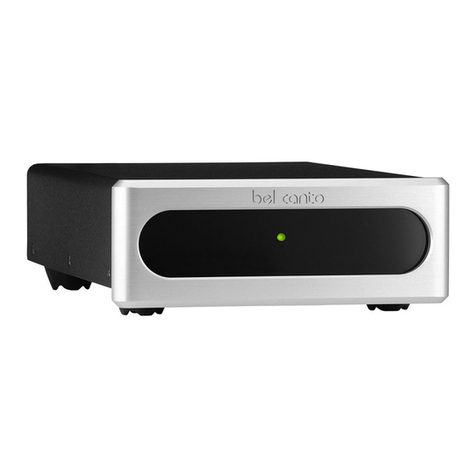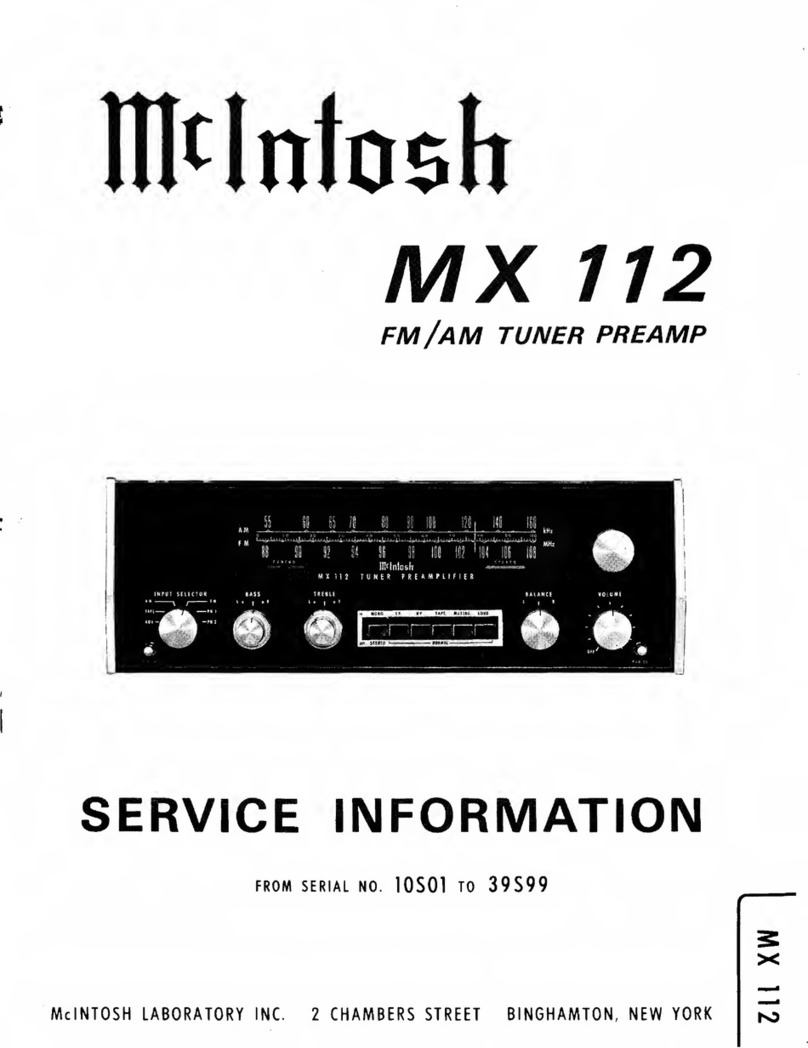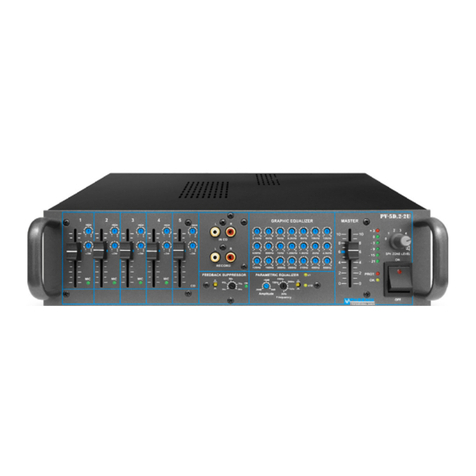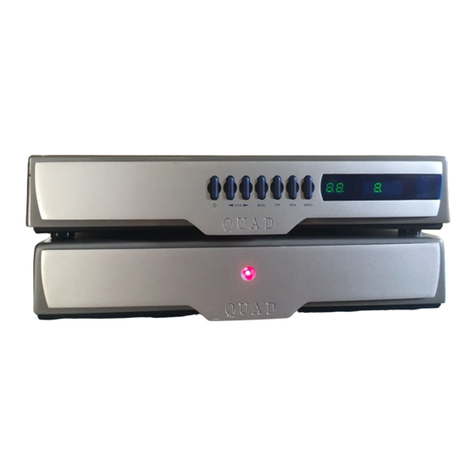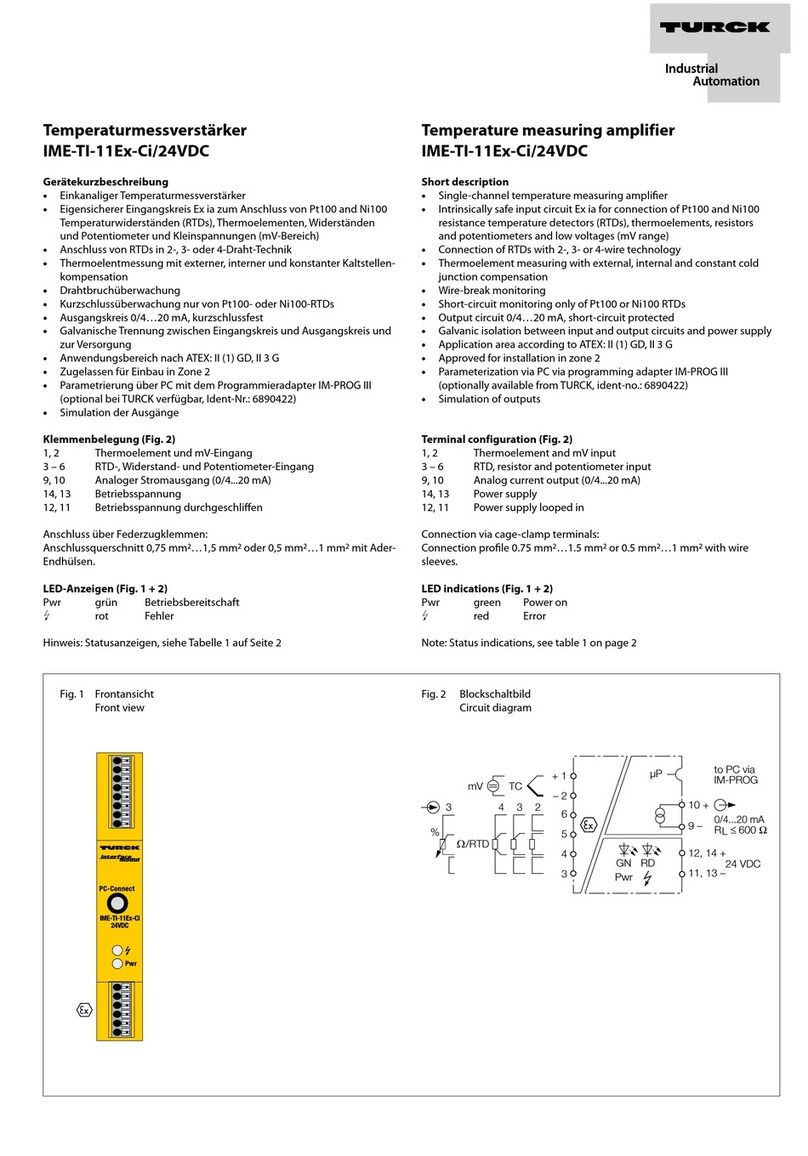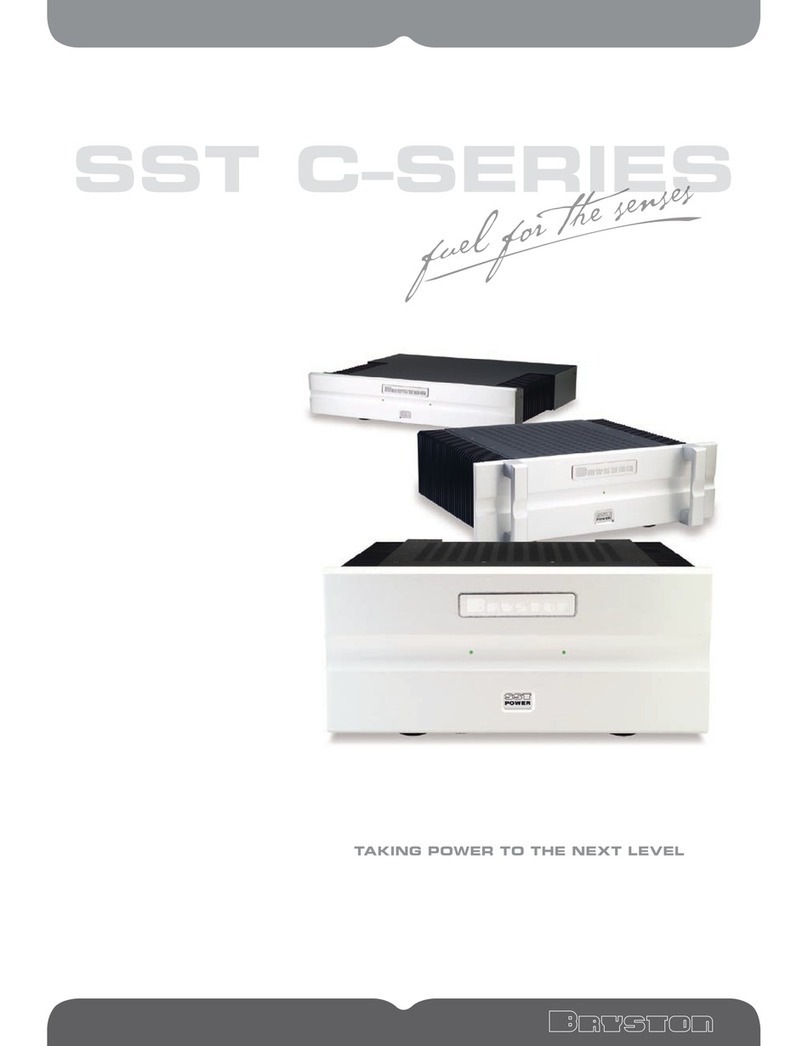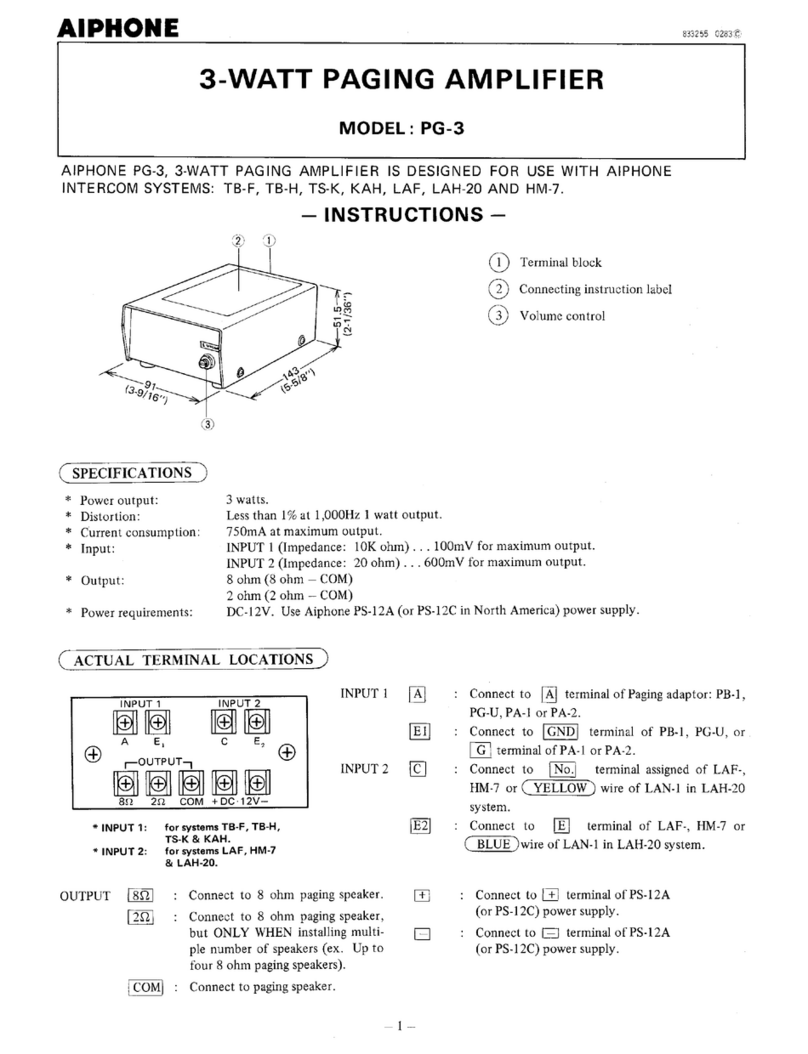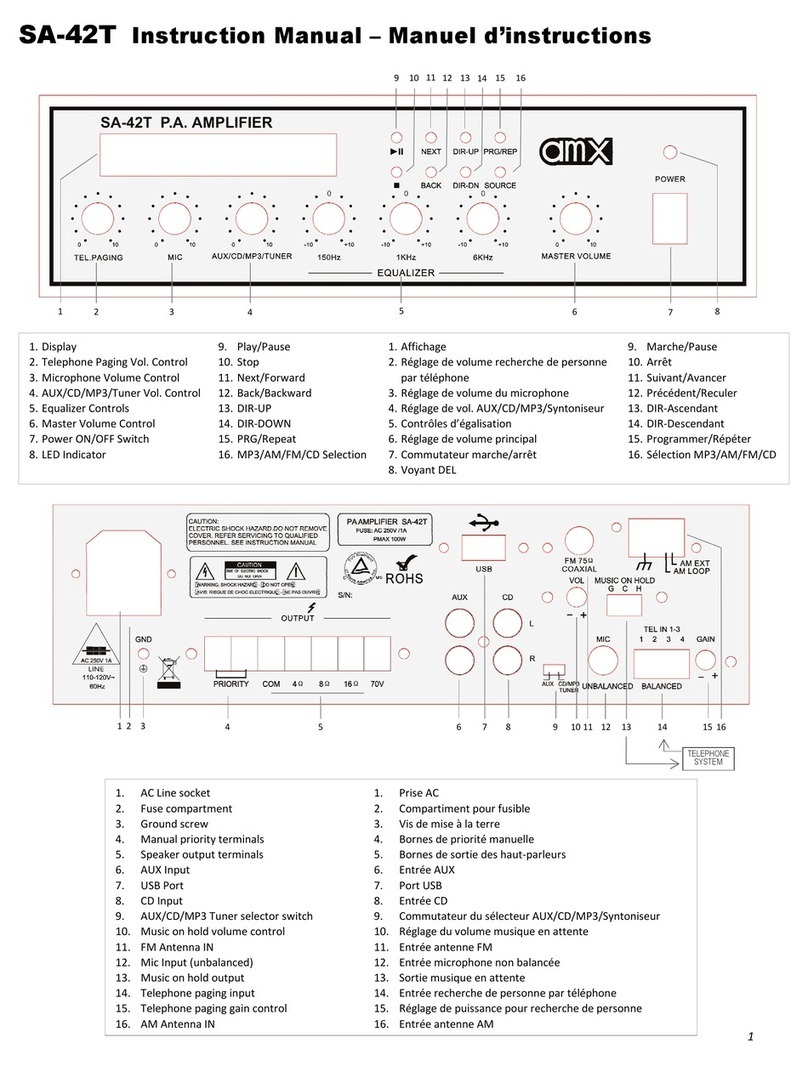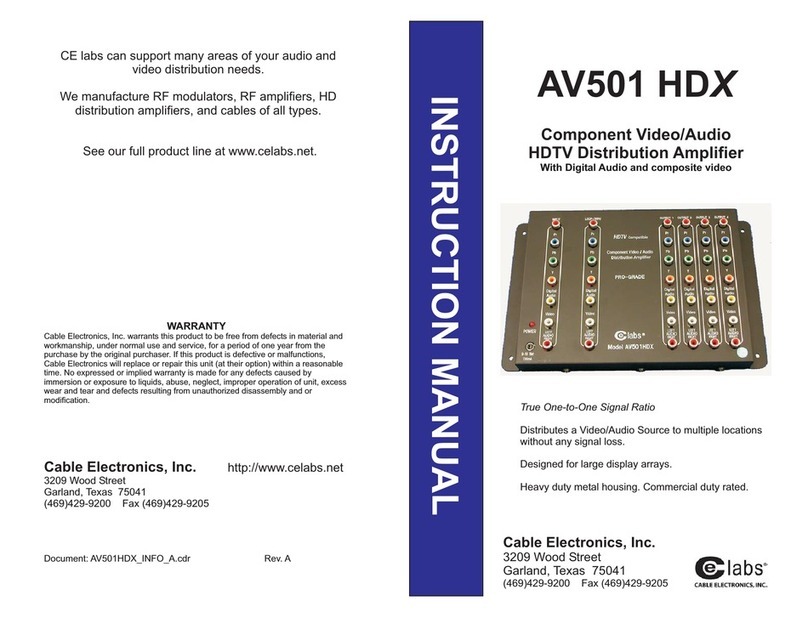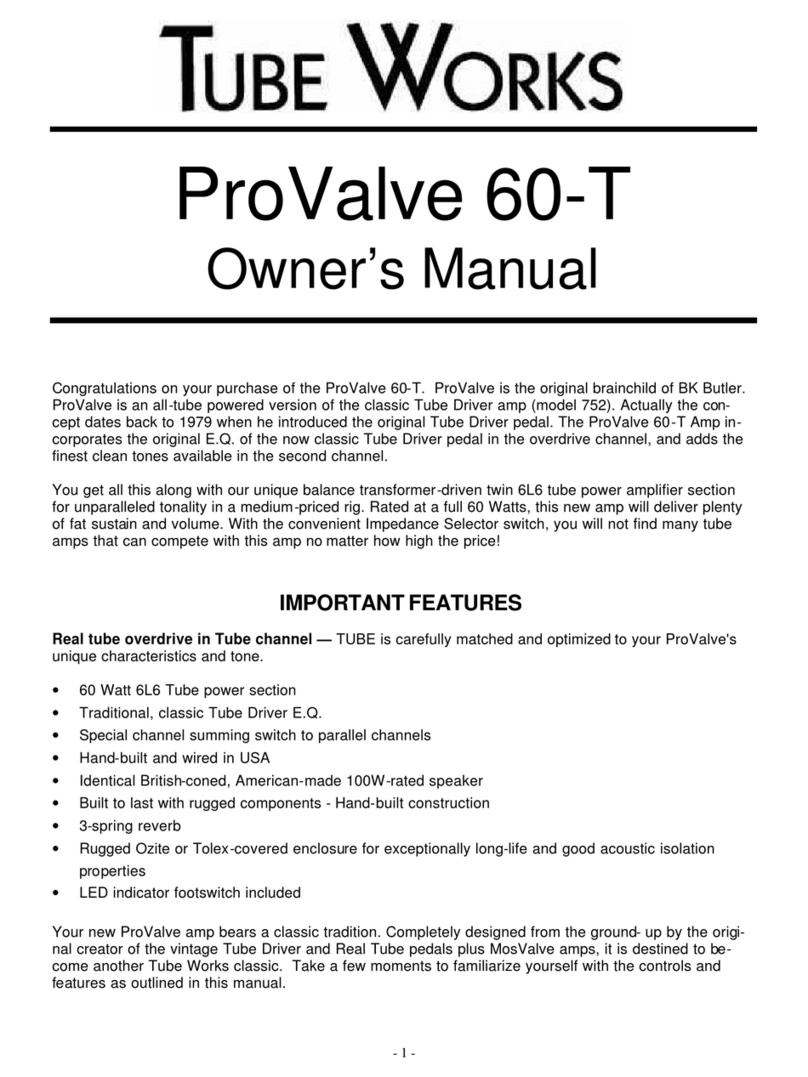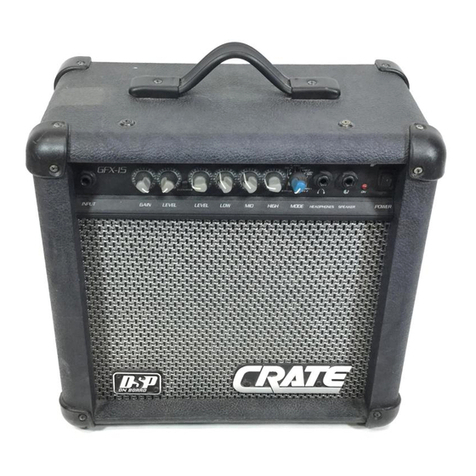bittner XB400 User manual

Application Handbook
Complete Edition
Bittner Audio Int. GmbH
http://www.bittner-audio.com
Version 2.3.1
March 3, 2016

Page 2Contents
Contents
1 General Information 6
1.1 Copyright&Acknowledgment.................................... 6
1.2 DeclarationofConformity ...................................... 6
1.3 EuropeanDirectives ......................................... 6
1.4 Disclaimer............................................... 6
1.5 SafetyInstructions .......................................... 7
1.6 WarrantyTerms&Conditions .................................... 7
1.7 Packaging ............................................... 8
1.8 Air Ventilation & Cooling Requirements . . . . . . . . . . . . . . . . . . . . . . . . . . . . . . . 8
1.9 InstallationinRack.......................................... 9
1.10PowerConnection .......................................... 9
2 Technical Features 10
2.1 ACPowerSwitch ........................................... 10
2.2 BackupPower............................................. 10
2.3 RemoteSwitching .......................................... 11
2.3.1 ControlVoltage....................................... 11
2.3.2 SXLII&RS–485 ...................................... 11
2.4 LEDIndicators ............................................ 12
2.4.1 Frontside .......................................... 12
2.4.2 Backside........................................... 12
2.5 LevelControl ............................................. 12
2.5.1 AnalogLevelControl.................................... 12
2.5.2 Digital Level Control (with stop) . . . . . . . . . . . . . . . . . . . . . . . . . . . . . 13
2.5.3 Digital Level Control (endless) . . . . . . . . . . . . . . . . . . . . . . . . . . . . . . 13
2.6 AudioConnections .......................................... 14
2.6.1 PHOENIX .......................................... 14
2.6.2 XLR/TRSJack ....................................... 14
2.7 GroundLift .............................................. 15
2.8 LoudspeakerOutputConnectors................................... 15
2.8.1 PHOENIX .......................................... 16
2.8.2 SPEAKON.......................................... 16
2.8.3 BindingPost ........................................ 16
2.9 OperationModes........................................... 16
2.9.1 StereoMode ........................................ 17
2.9.2 ParallelMode........................................ 17
2.9.3 BridgedOperation ..................................... 17
2.10AliveContact ............................................. 18
2.11DataPort ............................................... 18
2.11.1 I2C.............................................. 19
2.11.2 RS–485 ........................................... 19
2.12Address-IDs.............................................. 20
2.13NoiseGate............................................... 21
2.14EQCard................................................ 21
2.15LineMonitoring............................................ 22
3 Specifications of the Devices 23
3.1 BASICSeries ............................................. 23
3.1.1 GeneralInformation .................................... 23
3.1.2 Features........................................... 23
3.1.3 Front&RearView ..................................... 24
3.2 XBSeries ............................................... 25
3.2.1 GeneralInformation .................................... 25
3.2.2 Features........................................... 25
3.2.3 Front&RearView ..................................... 26
3.2.4 JumperandFuses ..................................... 27
3.3 XVSeries ............................................... 28
3.3.1 GeneralInformation .................................... 28
c
2016 Bittner Audio Int. GmbH

Contents Page 3
3.3.2 Features........................................... 28
3.3.3 Front&RearView ..................................... 29
3.3.4 JumperandFuses ..................................... 30
3.4 XVDCSeries ............................................. 31
3.4.1 GeneralInformation .................................... 31
3.4.2 Features........................................... 31
3.4.3 Front&RearView ..................................... 32
3.4.4 MultifunctionConnector.................................. 33
3.4.4.1 AudioInputs .................................. 33
3.4.4.2 RemotePowerOn................................ 33
3.4.4.3 Power Supply Fault Indication . . . . . . . . . . . . . . . . . . . . . . . . . 33
3.4.5 DIPSwitches ........................................ 34
3.5 XRSeries ............................................... 35
3.5.1 GeneralInformation .................................... 35
3.5.2 Features........................................... 35
3.5.3 Front&RearView ..................................... 36
3.5.4 Digital Signal Processor (DSP) . . . . . . . . . . . . . . . . . . . . . . . . . . . . . . 37
3.5.5 ControlbyRS–485andPC................................. 37
3.5.6 Emergency Paging Bus & Monitor Bus . . . . . . . . . . . . . . . . . . . . . . . . . . 38
3.6 4XSeries ............................................... 40
3.6.1 GeneralInformation .................................... 40
3.6.2 Features........................................... 40
3.6.3 Front&RearView ..................................... 41
3.6.4 JumperandFuses ..................................... 42
3.7 4Xi/4XeSeries ............................................ 43
3.7.1 GeneralInformation .................................... 43
3.7.2 Features........................................... 43
3.7.3 Front&RearView4Xi................................... 44
3.7.4 Front&RearView4Xe................................... 45
3.7.5 Fuses ............................................ 46
3.7.6 Loudspeaker Output Connectors 4Xe . . . . . . . . . . . . . . . . . . . . . . . . . . . 47
3.7.7 ClipLimiter......................................... 47
3.7.8 DanteTM Inputs....................................... 48
3.7.9 DIPSwitches ........................................ 48
3.8 4XDUALSeries............................................ 49
3.8.1 GeneralInformation .................................... 49
3.8.2 Features........................................... 49
3.8.3 Front&RearView ..................................... 50
3.8.4 JumperandFuses ..................................... 51
3.9 4DXVSeries.............................................. 52
3.9.1 GeneralInformation .................................... 52
3.9.2 Features........................................... 52
3.9.3 Front&RearView ..................................... 53
3.108XSeries ............................................... 54
3.10.1 GeneralInformation .................................... 54
3.10.2 Features........................................... 54
3.10.3 Front&RearView ..................................... 55
3.10.4 JumperandFuses ..................................... 56
3.11XTSeries ............................................... 57
3.11.1 GeneralInformation .................................... 57
3.11.2 Connections......................................... 57
3.128XTSeries............................................... 58
3.12.1 GeneralInformation .................................... 58
3.12.2 Front&RearView ..................................... 58
3.13 AX16 - Intelligent Amplifier Switch . . . . . . . . . . . . . . . . . . . . . . . . . . . . . . . . . 59
3.13.1 GeneralInformation .................................... 59
3.13.2 Features........................................... 60
3.13.3 Front&RearView ..................................... 61
3.13.4 LEDIndicators ....................................... 62
3.13.5 Configuration........................................ 62
c
2016 Bittner Audio Int. GmbH

Page 4Contents
3.13.5.1 SwitchingModes ................................ 63
3.13.5.2 Connected Amplifiers . . . . . . . . . . . . . . . . . . . . . . . . . . . . . . 63
3.13.5.3 Logic of Alive Contact . . . . . . . . . . . . . . . . . . . . . . . . . . . . . 64
3.13.5.4 ControlModes ................................. 64
3.13.6 ConnectionofAmplifiers.................................. 64
3.13.6.1 Signal and Amplifier Inputs . . . . . . . . . . . . . . . . . . . . . . . . . . 64
3.13.6.2 Amplifier Outputs and Loudspeakers . . . . . . . . . . . . . . . . . . . . . 65
3.13.6.3 Alive Contact of the Amplifiers . . . . . . . . . . . . . . . . . . . . . . . . . 65
3.13.7 DataPort .......................................... 66
3.13.8 LevelControl........................................ 66
3.13.9 AliveandActiveContacts ................................. 67
3.13.10 ApplicationExamples ................................... 68
3.13.10.1 Mode 7+1 with Alive Contacts . . . . . . . . . . . . . . . . . . . . . . . . 68
3.13.10.2 Mode 3+1 with SXL II and Alive Contacts . . . . . . . . . . . . . . . . . . 69
3.13.10.3 Mode 3+1 with 4 Channel Amplifiers and Alive Contacts . . . . . . . . . . 70
3.14SXLII-ControlInterface....................................... 71
3.14.1 GeneralInformation .................................... 71
3.14.2 Features........................................... 71
3.14.3 FrontandRearView.................................... 72
3.14.4 StartingUp ......................................... 73
3.14.4.1 NetworkConnection .............................. 73
3.14.4.2 Connection of the Amplifiers and the AX16 . . . . . . . . . . . . . . . . . . 73
3.14.4.3 AddressIDs ................................... 74
3.14.4.4 Settings of Network Parameters . . . . . . . . . . . . . . . . . . . . . . . . 75
3.14.5 LEDIndicators ....................................... 75
3.14.6 SpecialPorts ........................................ 76
3.14.6.1 LogicalInputs.................................. 76
3.14.6.2 Signalization Relays . . . . . . . . . . . . . . . . . . . . . . . . . . . . . . 77
3.14.6.3 General Purpose Relays . . . . . . . . . . . . . . . . . . . . . . . . . . . . . 77
3.14.6.4 SignalGenerator ................................ 77
3.14.7 ManualOperation ..................................... 78
3.14.7.1 Menus&Parameters .............................. 78
3.14.7.2 Entry & Service Modes . . . . . . . . . . . . . . . . . . . . . . . . . . . . . 79
3.14.7.3 Saving and Loading of Configurations . . . . . . . . . . . . . . . . . . . . . 79
3.14.8 WebInterface........................................ 80
3.14.8.1 Status ...................................... 81
3.14.8.2 Settings ..................................... 82
3.14.8.3 DSP ....................................... 82
3.14.8.4 Monitoring ................................... 83
3.14.8.5 Signalization .................................. 84
3.14.8.6 Configurations ................................. 85
3.14.8.7 AX16....................................... 85
3.14.8.8 Misc ....................................... 86
3.14.8.9 Log........................................ 88
3.14.8.10Home ...................................... 88
3.14.9 SpecialFunctions...................................... 89
3.14.9.1 Configuration Switching via the Logic Inputs . . . . . . . . . . . . . . . . . 89
3.14.9.2 ErrorMatrix................................... 90
3.14.9.3 LineMonitoring................................. 90
3.14.9.4 Error Acknowledgment . . . . . . . . . . . . . . . . . . . . . . . . . . . . . 91
3.14.9.5 BackupSwitching................................ 92
3.14.9.6 Permanent Backup of Operation Modes . . . . . . . . . . . . . . . . . . . . 93
3.14.10 Software&Files ...................................... 94
3.14.10.1FTP........................................ 94
3.14.10.2Firmware .................................... 94
3.14.10.3SystemSettings................................. 95
3.14.10.4 Web Interface (Files) . . . . . . . . . . . . . . . . . . . . . . . . . . . . . . 95
3.14.10.5Configurations ................................. 95
3.14.10.6Logbook..................................... 96
3.14.11 AmplifierFunctions .................................... 96
c
2016 Bittner Audio Int. GmbH

Contents Page 5
3.14.12 ErrorCodes......................................... 97
4 General Technical Information 99
4.1 Decibel ................................................ 99
4.2 100V ................................................. 99
4.3 MeasuringAmplifierPower .....................................100
4.4 Heat Dissipation and Air Conditioning . . . . . . . . . . . . . . . . . . . . . . . . . . . . . . . 101
4.5 Sound Pressure and Amplifier Power . . . . . . . . . . . . . . . . . . . . . . . . . . . . . . . . 101
4.6 Essentials ...............................................103
4.6.1 Load-to-Power Relation in 100 V Systems . . . . . . . . . . . . . . . . . . . . . . . . 103
4.6.2 CrestFactor.........................................103
4.6.3 Resistance-Power .....................................103
4.6.4 VoltagesindBVanddBu..................................103
4.6.5 „dB“-Relations .......................................103
4.6.6 Conversion of THD to „dB below signal level“ . . . . . . . . . . . . . . . . . . . . . . 104
4.6.7 VoltagetoPower ......................................104
5 Technical Data 105
6 Troubleshooting 107
List of Figures 108
c
2016 Bittner Audio Int. GmbH

Page 61 General Information
1 General Information
1.1 Copyright & Acknowledgment
c
2016 Bittner Audio. All Rights Reserved.
Bittner Audio reserves specification privileges Information in this manual is subject to change without no-
tice.
Congratulations and thank you for buying Bittner Audio.
1.2 Declaration of Conformity
Bittner Audio hereby declares that this product is in accordance with the following standards:
•LVD Directive 2006/95/EC
•EMC Directive 2004/108/EC
•EN 60065: 2002 + A1: 2006 + A11: 2008 + A2: 2010 + Al2: 2011
•EN 60950–1: 2006 + A11: 2009 + A1: 2010 + A12: 2011 + A2:2013
•EN 55022: 2010
•EN 50130–4: 2011
•EN 50121–4: 2006
•EN 61000–3–2: 2006 + A1: 2009 + A2: 2009
•EN 61000–3–3: 2013
•EN 61000–6–2: 2005
•EN 61000–6–4: 2007 + A1: 2011
1.3 European Directives
Bittner Audio also declares that the products are in compliance with the requirements of the European
Directives 2002/96/EC (WEEE) and 2002/95/EC (RoHS).
The primary aim of the WEEE Directive and RoHS Directive is to reduce the impact of disposal of electrical
and electronic equipment at end-of-life. The WEEE Directive aims to reduce the amount of WEEE sent for
disposal to landfill or incineration by requiring producers to arrange for collection and recycling. The RoHS
Directive bans the use of certain heavy metals and brominates flame retardants to reduce the environmental
impact.
1.4 Disclaimer
In no case shall Bittner Audio be liable for any special, incidental, or consequential damages to loudspeakers,
amplifiers, or other equipment if such damages are based upon negligence during installation or operation.
Such damages include, but are not limited to, loss of profits or any other loss of property of the purchaser. In
case the contractual liability of Bittner Audio is excluded or limited, this also applies to the personal liability
of employees, representatives, assistants and other auxiliary persons.
c
2016 Bittner Audio Int. GmbH

1 General Information Page 7
Should any part of the equipment show defects in materials and workmanship, including transport damage,
the customer is asked to complain to Bittner Audio. Failure of complaint, however, has no consequences for
your legal claims.
Bittner Audio points out that all specifications may be subject to change without notice and that liability
for incorrect, incomplete or outdated information is excluded. This warranty does not affect your statutory
rights.
Caution
International: Please contact your supplier for specific regional information, as rights and dis-
claimers may vary from country to country.
1.5 Safety Instructions
Caution
To reduce the risk of electrical shock, do not remove the cover. There are no user serviceable
parts inside, refer all servicing to qualified personnel. Replace fuses only with same type. Avoid
damaging the AC plug or cord. Damage may potentially cause a shock hazard. The apparatus
should only be connected to an AC power supply of the correct voltage.
Never isolate the ground of the AC power cord (the non-fused earthed protective conductor) to
eliminate hum-problems.
To reduce the risk of fire or electrical shock, do not expose this apparatus to rain or moisture
and don’t use it in damp areas or near water. The apparatus shall not be exposed to dripping or
splashing water and no objects filled with liquids shall be placed on the apparatus.
The apparatus must be adapted slowly to extreme temperature changes. These extreme changes
can cause inside moisture development that can cause failure and/or electrical shock.
The power fuses are located on the back panel of the apparatus and may be accessed from the
outside. Use only the appropriate fuses as labeled.
Always use safe operating techniques! Incompetent and improper servicing will void the war-
ranty.
Though all Bittner Audio devices are quite simple to operate and are covered by a solid steel
chassis, improper use may be dangerous. Some of the units can put out very high voltages and
a sizable current at frequencies up to 30 kHz. Any connections to the speaker terminals marked
with a „lightning symbol“ shall be made only by an instructed person.
Figure 1.1: Lightning Symbol
1.6 Warranty Terms & Conditions
Bittner Audio warrants this product to be free from defects in materials and workmanship.
Should any part of this equipment be defective, the Manufacturer agrees to repair or replace any defective
part free of charge (except transportation charges) for a period of three years from the date of the original
purchase.
c
2016 Bittner Audio Int. GmbH

Page 81 General Information
Warranty service is effective and available to the original purchaser only.
To obtain service under this warranty, the product must, on discovery of the defect, be properly packed and
shipped to the nearest Bittner Audio dealer. The party requesting service must provide proof of original
ownership and date of purchase of the product.
If the warranty is valid, Bittner Audio will, without charge for parts or labor, either repair or replace the
defective parts. Without a valid warranty, the entire cost of the repair is the responsibility of the product’s
owner.
The warranty does not cover defects or repairs needed as a result of:
1. Damage caused by abuse, accident, or negligence.
2. Damage caused by any tampering, alteration, or modification of the product or its components.
3. Damage caused by failure to maintain and operate the product in strict accordance to the written
instruction of this operating manual.
4. Damage caused by repairs or attempted repairs by unauthorized persons.
5. Damage caused by fire, water and other natural events.
6. Damage caused by operation on improper voltages.
1.7 Packaging
Upon unpacking, please inspect the product. If you find any damage, notify your supplier immediately. Be
sure to save the carton and all packing materials in case you have to send the product to the supplier.
Please use only the original factory packing. If the shipment carton is unavailable, contact Bittner Audio
International GmbH (www.bittner-audio.com) to obtain a replacement.
1.8 Air Ventilation & Cooling Requirements
The devices are equipped with a forced air-cooling system with variable speed and temperature controlled
fans to guarantee low operating temperature and minimal ventilation noise. The air flow takes place from
the rear to the front of the amplifier. The air-pulling fans are installed on the back side of the unit. The air
flow is always from the front to the rear side.
In case a heat sink becomes too hot, the temperature sensor opens the respective output relay, disconnecting
the output load from the particular channel. In case the power transformer gets overheated, a different
sensor causes the output relays on all channels to open and to interrupt the outputs. After cooling down to
an appropriate operating temperature level the relay contacts are closed again automatically.
It is important to have adequate air ventilation space behind the amplifier to allow a proper air flow. In case
the amplifier is mounted inside a closed rack, do not cover the front of the rack with doors. If using racks
with a closed backside, use fans on the rear rack panel. Bittner Audio recommends one open rack space for
every 2 mounted power amplifiers.
c
2016 Bittner Audio Int. GmbH

1 General Information Page 9
1.9 Installation in Rack
All devices will mount in standard 19-inch racks having sufficient depth and should be mounted with four
standard rack bolts. To avoid the deformation of the chassis it is recommended to mount heavy units on
horizontal brackets.
Please ensure a sufficient airflow. In the case, closed racks are being used rack-fans should be used. For
larger installations one open rack space (1 RU) for every 2 mounted power amplifiers should be provided.
1.10 Power Connection
The power amplifier must be connected only with the attached three-wire safety power cord with protective
conductor (non-fused earthed conductor).
This amplifier is made for use with the mains voltage labeled on the back of the amplifier only. Check the
label on the back panel of the amplifier for the appropriate voltage. Make sure the voltage of your mains
outlet is correct. The power voltage is factory set as labeled on the back panel and cannot be changed
afterwards. Damage caused by connecting the amplifier to improper AC voltage voids the warranty.
Caution
Never isolate the ground of the AC power cords (the non-fused earthed protective conductor) to
eliminate hum-problems.
Always turn off and disconnect the amplifier from the mains voltage before making any audio connections.
As a precaution, turn the audio attenuators on the front panel down during powering up.
The power fuses are located on the back panel of the amplifier and can be accessed from the outside. Use
only the appropriate fuses as labeled.
After properly mounting and connecting the AC cord and the audio connections, the unit can be switched
on.
c
2016 Bittner Audio Int. GmbH

Page 10 2 Technical Features
2 Technical Features
2.1 AC Power Switch
If the remote switching option is not being used, the device must be switched on and off with the main
power switch.
Caution
The amplifier unit is only fully disconnected from the mains voltage by unplugging the power
cord.
To use the remote power switching option, the main power switch must be set as follows:
Amplifier Position
XB 400/800 Off
XB 1600/2200 On
XV Off
XV DC On
XR DSP Off
4X On
4Xi On
4Xe On
4X DUAL Off
4DXV On
8X Off
2.2 Backup Power
The amplifiers of the the XV DC and 4DXV Series are equipped with a 24 V backup power supply. In case of
a loss of the mains supply the amplifier will switch automatically to the 24 Volt input. The DC current will
be limited for safety reasons.
Caution
The 24 Volt DC supply input must be protected by an external fuse.
Figure 2.1: Backup Power Connector
c
2016 Bittner Audio Int. GmbH

2 Technical Features Page 11
2.3 Remote Switching
2.3.1 Control Voltage
In this mode the PHOENIX terminal block (see picture) is used to remotely power up the amplifier with a
control voltage (12 VDC 80mA). Terminal IN +/–12V is used as the control voltage input. Feeding these
terminals with the control voltage will switch the amplifier on.
Figure 2.2: Remote Switching PHOENIX Connector
After a delay of one second the control voltage will appear on the terminals labeled OUT +/–12V of the
PHOENIX terminal block. The OUT terminals may be connected to the terminals IN of the next amplifier for
sequential power switching.
Up to 16 units may be daisy-chained this way. The control voltage must be applied until the last amplifier in
the daisy-chain is being switched on. Each amplifiers draws 80mA.
By supplying the inverted DC control voltage to terminal IN, all connected amplifiers will be switched off.
Pin Function
IN+ Amplifier Switching POSITIVE terminal
IN- Amplifier Switching NEGATIVE terminal
OUT+ Control Voltage output for sequential switching POSITIVE terminal
OUT- Control Voltage output for sequential switching NEGATIVE terminal
Caution
To use the remote power on, the mains power switch needs to be switched On or Off, depending
on the amplifier model (refer to section 2.1).
2.3.2 SXL II & RS–485
If the device is connected to a Bittner Audio SXL II or via the RS–485 interface to a PC (XR only), the unit
can be remotely switched on and off at any time.
c
2016 Bittner Audio Int. GmbH

Page 12 2 Technical Features
2.4 LED Indicators
2.4.1 Frontside
The amplifiers are equipped with 4 LEDs for each amplifier channel:
LED Color Function
POWER green The amplifier is powered up.
CLIP red The input is overloaded. The LED starts illuminating as soon as the signal is 0.5 dB
under full power.
SIGNAL green The signal reaches the output stage of the amplifier.
PROTECT red This LED will light up as soon a protection circuit has been activated or if one of the
output relays has been activated. When the amplifier is switched on, this LED will
light up for approximately 1.5 seconds.
The amplifiers of the XB and XV Series feature an Overheat LED on the front panel. If the amplifier reaches
an operational temperature of 90◦Celsius the LED will light up.
The amplifiers of the XV DC and 4DXV Series are equipped with 2 additional LEDs on the front panel for the
supply voltages:
LED Color Function
AC POWER green Mains is present
DC POWER green Backup Power +24V is present
2.4.2 Backside
Amplifiers with an incorporated micro controller use an LED to indicate its operational status:
•slow blinking (about 1x/sec): All channels are OK
•fast blinking (about 3x/sec): Either the power supply failed or at least one of channels is in protect
Caution
After a power on of the amplifier the LED is blinking fast (up to 3 sec.) until all internal supply
voltages have reached their correct levels.
Figure 2.3: Amp Status
2.5 Level Control
2.5.1 Analog Level Control
The amplifiers are equipped with two analog level control knobs, which are setting the level of the amplifier.
The adjusting range is –90dB to 0dB. The 16 different settings of the switch are as follows:
c
2016 Bittner Audio Int. GmbH

2 Technical Features Page 13
–90, –60, –30, –24, –21, –18, –15, –13, –11, –9, –7, –5, –4, –3, –1 und 0 dB.
Figure 2.4: Analog Level Controls
2.5.2 Digital Level Control (with stop)
The devices are equipped with a rotary switch per channel of the amplifier, which is setting the level of
the amplifier. The adjusting range is –90dB to 0dB. The 16 different settings of the digital switch are as
follows:
–90, –78, –66, –54, –42, –30, –24, –18, –15, –12, –9, –6, –3, –2, –1 and 0 dB.
Figure 2.5: Digital Level Controls (with stop)
Caution
Please keep in mind that the position of the rotary control will be detected by a microcontroller
which will then set the according level of the amplifier when it’s switched on.
The XR series is an exception: The last set level is stored in the DSP. After powering up, the
amplifier will be set to this level. Furthermore the stored level will be ignored if the rotary
control is being set to –90dB.
2.5.3 Digital Level Control (endless)
The devices are equipped with a rotary switch per channel of the amplifier, which is setting the level of
the amplifier. The adjusting range is –90dB to 0dB. The 16 different settings of the digital switch are as
follows:
–90, –78, –66, –54, –42, –30, –24, –18, –15, –12, –9, –6, –3, –2, –1 and 0 dB.
Figure 2.6: Digital Level Controls (endless)
c
2016 Bittner Audio Int. GmbH

Page 14 2 Technical Features
Caution
There is no stopping position for the rotary control. If the switch is turned beyond –90dB setting
to the 0dB setting, the level will not jump from full attenuation to full power but remain in the
–90dB position.
This feature will prevent the destruction of connected equipment and/or injury of persons. As
the rotary direction is being sensed, it is necessary to turn the switch clockwise again to set the
amplifier to higher levels.
Please keep in mind that the position of the rotary control will be detected by a microcontroller
which will then set the according level of the amplifier.
If the amplifier was operated at full attenuation before turning it off with the rotary control
accidentally set to 0dB it will start up with full power!
In the opposite case it will start up fully attenuated at –90dB and you won’t hear any audio!
2.6 Audio Connections
The amplifiers may be operated with unbalanced or balanced lines. For optimum performance use balanced
lines whenever possible. The driving device should be equipped with a balanced output.
Nevertheless, short cables inside a rack are not that critical. In these cases unbalanced cables may be used.
Caution
Always turn off the amplifier before making any connections. As an additional precaution by
switching the amplifier on for the first time, turn the audio attenuators down during powering
up.
2.6.1 PHOENIX
The Phoenix audio connectors are electronically balanced. Each input contains three pins: Signal (+),
Signal (-) and Shield. Depending on the model more than one channel might be combined on the PHOENIX
connector.
2.6.2 XLR /TRS Jack
The amplifiers series BASIC, 4Xe and XR are equipped with two combined input connectors. They can be
used for regular XLR connectors and for 6.3 mm TRS jacks, mounted in the same connector chassis. The
audio inputs of the BASIC and XR amplifiers are electronically balanced.
Standard pinout for the XLR connectors:
1 - Ground, Shield | 2 - Signal (+) | 3 - Signal (-)
Figure 2.7: XLR Connector
c
2016 Bittner Audio Int. GmbH

2 Technical Features Page 15
Standard pinout for the 6.3 mm TRS-jack:
Tip - Signal (+) | Ring - Signal (-) | Sleeve - Ground, Shield
Figure 2.8: TRS Jack
2.7 Ground Lift
The chassis ground of the amplifier is connected with the ground of the AC power cord (the non-fused
earthed protective conductor). Therefore, if several devices are connected in a signal chain a ground loop
may be created.This ground loop will cause a compensating current to travel on the shields of the audio
cables causing hum-problems.
The amplifiers series BASIC, XB and XR are equipped with a Ground Lift switch on the back side of the unit.
It has three settings:
Character Signification/Meaning
Signal ground (Audio) is seperated from chassis ground
Signal ground (Audio) is connected to chassis ground
Signal ground (Audio) is connected to chassis ground via a 10 ohms resistor
Setting 1 and 3 will remove hum in most cases.
Caution
Although Ground Lift is a common and proven method, proper cabeling and grounding should
avoid hum in the first place.
Isolating the ground of the AC power cord is technically different and eliminates the protective
earth connection. Therefore, NEVER isolate the ground of the AC power as this may pose a
serious danger to your life.
2.8 Loudspeaker Output Connectors
Use heavy gauge wire. It is advisable to use thicker cables to bridge greater distances between amplifier and
speakers. This will minimize power losses across the wire and improve the damping factor.
Please note: Wire thickness specifications (gauges) get larger as the wire gets thinner. So a 14-gauge wire is
thicker than 18-gauge wire.
c
2016 Bittner Audio Int. GmbH

Page 16 2 Technical Features
2.8.1 PHOENIX
The Phoenix audio connectors contain two pins per channel: Signal (+) and Signal (-). Depending on the
model more than one channel might be combined on the PHOENIX connector.
Caution
OUTPUT TERMINAL SAFETY WARNINGS:
The removable PHOENIX terminal block must be fastened to the amplifier’s output connector by
screws.
Do not touch output terminals while amplifier power is on. Make all connections with amplifier
turned off. Risk of hazardous energy!
2.8.2 SPEAKON
Speaker cables may be connected to the 4 pin NEUTRIK SPEAKON connectors.
Pin-out SPEAKON connector NL4FC for channel 1 and 2:
Pin Function
1+ Output (+)
1- Output (-)
2+ n/c
2- n/c
The PHOENIX connectors are connected in parallel to channel 1 and 2 of the SPEAKON connectors. It is
possible to use both connections at the same time (to parallel several loudspeakers). In this case the polarity
of the speakers has to be the same. It is also important not to go below the minimum load impedance of the
amplifier.
2.8.3 Binding Post
The Binding Posts contain two pins per channel: Signal (+) and Signal (-). Every two channels are combined
on one block.
Caution
OUTPUT TERMINAL SAFETY WARNING! Do not touch output terminals while amplifier power
is on. Make all connections with amplifier turned off. Risk of hazardous energy!
2.9 Operation Modes
On the rear of the amplifier three different operation modes can be selected on the DIP-Switch panel:
•STEREO
•PARALLEL
•BRIDGED MODE
The amplifier must be re-powered before the mode change is activated.
c
2016 Bittner Audio Int. GmbH

2 Technical Features Page 17
Caution
If the amplifier doesn’t have a switch, the operation mode has to be set up by the wiring of the
inputs and loudspeaker outputs.
2.9.1 Stereo Mode
For stereo operation set the mode select switch to STEREO (factory default). Models without a switch
are automatically working in stereo mode. Please connect the input signals for both channels to the input
connectors of CH1 AND CH2.
The input signals are available on the corresponding output channel.
2.9.2 Parallel Mode
In PARALLEL mode both amplifier channels get the same input signal.
In case of a mode switch set it to PARALLEL. Connect the input signal to input CH1 (Channel 2 is disabled).
The input signal of channel 1 is available on both output channels.
In case of no mode switch simply connect both inputs to the same audio source.
2.9.3 Bridged Operation
Both amplifiers may be bridged together to create a powerful single-channel mono amplifier.
Caution
This operation mode is not available for the amplifiers with 100V outputs.
In case of a mode switch it needs to be set to the BRIDGE position. Connect the input signal to CH1 (Channel
2 is not active). The amplified signal is now available on both positive (+) pins of the output terminals.
Even in case of no mode switch each pair of channels can operate in bridge mode. This is achieved by using
a reversed polarity of the channels to each other. The second channel gets the same input signal, but the
plus and minus pins are connected the other way round.
Figure 2.9: Wiring in Bridge Mode with no mode switch
Caution
Both potentiometers remain active and should be set to the same value.
c
2016 Bittner Audio Int. GmbH

Page 18 2 Technical Features
2.10 Alive Contact
All Bittner Audio amplifiers (with the exception of the BASIC and 4X DUAL Series), the Switching Unit AX16
and the SXL II Control Interface are equipped with an Alive contact.
The GPI contact is located on the rear panel of the amplifier and indicates the operational condition of the
amplifier. It is designed as a 3-pole contact closure that may be used in the open or the closed mode.
Caution
The AX16 is equipped with a 2-pole contact (normally open). It works like pin 2+3 of the 3-pole
contact
Figure 2.10: Alive Contact
State Position Funktion
Alive Contact
active
pins 2+3
connected
indicates that the amplifier is working in normal conditions
Alive Contact
inactive
pins 1+2
connected
indicates that the amplifier is not working properly: it is shut down
by the protection circuit, overheated etc. or generally switched off
This contact closure is the simplest form of remote system monitoring of the amplifier without establishing
a remote control network and provides easy system surveillance. The Alive Contact may also be integrated
into a media control network as a GPI contact closure to trigger other control functions, i.e. backup amplifier
(spare amplifier) switching, if required.
2.11 Data Port
Bittner Audio amplifiers Series XR, 4X, 4Xi, 4Xe, 4X DUAL, 8X and the switching unit AX16 are equipped
with the SXL II data port, which allows the monitoring and control of the amplifier by an SXL II Control
Interface (refer to SXL II section 3.14).
Device Data Port
AX16 I2C
4X RS–485
4Xi RS–485
4Xe RS–485
4X DUAL I2C
8X I2C
XR I2C und RS–485
Up to 16 amplifier channels may be connected to the SXL II. The 16 amplifier channels may be freely
combined of 2-, 4- and 8-channel amplifiers.
c
2016 Bittner Audio Int. GmbH

2 Technical Features Page 19
After the amplifier has been connected to the SXL II, it will be automatically recognized. The Link LED on
the SXL II front panel indicates ON. Communication with the SXL II unit is indicated by the fast blinking
green (TX) LED on the amplifier’s rear panel.
For more details please refer to SXL II section 3.14.
2.11.1 I2C
Figure 2.11: I2C Data Port
Pin Function
1 SDA I2C Data
2 SCL I2C Clock
3, 11 +12V Supply
4, 6, 8, 9, 10, 12, 14 Ground Supply
5, 7, 13, 15 n/c
Caution
The 12V supply drives the Data-Interface of an amplifier in case the mains supplies have been
turned off or interupted.
2.11.2 RS–485
The RS–485 interface on the XR Series amplifiers is a half-duplex transceiver with one single bus (2-wire)
for transmitting and receiving data on the same bus.
DATA+ is pulled via 10k resistor to +5V volts and DATA- is pushed to RS–485 GND via 10k in idle state.
Figure 2.12: RS–485 Data Port
Figure 2.13: RS–485 Connector
c
2016 Bittner Audio Int. GmbH

Page 20 2 Technical Features
Pin Function
3, 6 DATA+
4, 5 DATA-
1, 8 Ground
2, 7 n/c
Amplifiers with a RS–485 interface are equipped with two parallel ports, PORT1 and PORT2 (RJ–45). To
establish a RS–485 bus topology, PORT1 should be used as an input and PORT2 as the output to the next
amplifier in the chain.
Two LED indicators are active while receiving data (red=RX) and transmitting data (green=TX) over RS–
485.
2.12 Address-IDs
To connect the amplifiers to the SXL all amplifiers must have a unique address. The address is selected on
the DIP switch at the rear panel of the amplifier.
Multichannel amplifiers receive several consecutive IDs. Every amplifier module consisting of two channels
gets one ID.
Caution
After an address change the amplifier must be disconnected from the data port connection and
re-powered to activate the changes!
DIP Switch settings for 2-Channel-Amplifiers:
Address SW1 SW2 SW3
ID 1 ON ON ON
ID 2 OFF ON ON
ID 3 ON OFF ON
ID 4 OFF OFF ON
ID 5 ON ON OFF
ID 6 OFF ON OFF
ID 7 ON OFF OFF
ID 8 OFF OFF OFF
DIP Switch settings for 4-Channel-Amplifiers:
Address SW1 SW2
ID 1+2 OFF OFF
ID 3+4 ON OFF
ID 5+6 OFF ON
ID 7+8 ON ON
DIP Switch settings for 8-Channel-Amplifiers:
Address SW1 SW2
ID 1+2+3+4 OFF OFF
ID 5+6+7+8 ON ON
c
2016 Bittner Audio Int. GmbH
This manual suits for next models
6
Table of contents
Other bittner Amplifier manuals
